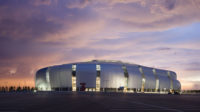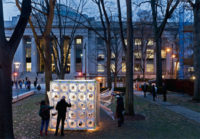The Metropolitan Opera’s new production of Verdi’s Rigoletto premiered this this winter to rave reviews—including its set design by Christine Jones, known for her Broadway shows Hands on a Hardbody and the Tony award-winning American Idiot. Rigoletto’s director Michael Mayer has placed the staging of the opera in 1960s Las Vegas, rather than late Renaissance Mantua as originally conceived for the 1851 opening. Architects have responded enthusiastically to the glitzy “Rat Pack” aura of the Vegas sets at the Met. George Miller, partner of Pei Cobb Freed, recently urged William Pedersen of Kohn Pedersen Fox to see it: "Rigoletto's first act has a dynamic, colorful, and explosive set that instantly transports you from Lincoln Center to Las Vegas! Viva Las Vegas!" he exclaimed to Pedersen.
In a recent interview, Record discussed the new production with Jones, who besides designing for opera and stage, is on the faculty of New York University’s Tisch School of the Arts.
How did director Michael Mayer explain the rationale for the new production of Rigoletto based in 1960s Las Vegas?
Mayer was looking for a parallel environment, one, which like Mantua in the 16th century, was licentious, decadent, and very much a man's world. The Duke became a Sinatra type with a retinue of gamblers, performers, men of questionable character, and jokers such as Don Rickles who was one if our templates for Rigoletto, the Duke's jester.
How did you and Mayer collaborate?
I would say we have a combined vision. I often call Michael my other husband [Jones is married to actor Dallas Roberts]. We have an extremely close working relationship and we have a confidence in each other that is both exciting and stabilizing. We were asked to create this production in an extremely short amount of time, while both of us were in the middle of other projects. He felt our shorthand would be invaluable, but that we also know how to take each other's ideas and run with them relay style—how to take turns carrying the baton. It was personally rewarding for all of us, including Kevin Adams [lighting designer], Steven Hoggett [choreographer], and Susan Hilferty [costume designer], to make our Met debuts together.
What sort of research did you undertake in concocting a Las Vegas of 50 years ago?
Neon, neon, and more neon...I looked at neon from every period I could find and from every discipline—from signage to installation art.
What about Robert Venturi, Denise Scott Brown, and Steven Izenour’s landmark book Learning from Las Vegas (1972) as a source? Was that important?
Yes! Kevin suggested I look at that book and there was a black and white blurred image near the back that jumped out at me. It was a double- or triple- exposure image and made me think about seeing the Strip through a haze of alcohol and drugs, which is how most people see Vegas. Suddenly I had permission to imagine a world that is more skewed. As the story progresses, the events, the characters, and the world itself—the neon—becomes more unraveled and chaotic. In Act I, neon is signage. In Act II, it is sculptural, in Act III, it is literally the storm and a scribble on the horizon.
Regarding the casino in Act I, what challenges did you have in creating the set of neon lights? Was the large size of the stage a problem? What about making sure singers are able to move around?
We used flexible plastic neon. We probably could not have done this show in the same way a few years ago. There are so many great products available now that we were able to get the look we needed without using glass neon tubes, which would have been impossible to maintain in the Met’s repertory situation.
I wanted the set to feel intimate and immediate, electrically tangible. So I made the plan as small as I could and pushed action as far downstage as possible for the number of people in the cast. I was terrified it would be too small, but my assistant and I kept putting in all the model figures, and the staff at the Met assured us it would be okay. I knew I could trust their instincts, even though I did have butterflies up until all the singers were in their places!
Act II occurs in the Duke’s penthouse at the casino. What were your sources of inspiration? Regarding the architecture of the set, how did you arrive at the round elevator towers connected by the curved wall and the large gold figure at the center?
First I had the idea that Rigoletto was keeping his daughter under lock and key within the hotel. We imagined that the Duke owned the hotel, the way Sinatra had a stake in The Sands, and that he lived in the penthouse. When I was 20 I first visited Caesars Palace and was struck by how it was a world onto itself. Once you entered you didn't leave, and everyday became more surreal. I looked at all the hotels on the Strip and loved the architecture of the Flamingo Hotel, especially the way it echoed the brass-ringed details in the lobby of the Met Opera [designed by Wallace Harrison]. The chandeliers in Act II are copies of the ones in the Met. I always try to find ways to connect the stage space to the theater and in this instance, the opera house, built in the mid-1960s, was especially meaningful to quote. I don’t recall where the golden statue of a female figure came from—it may have been for a bank. But I felt it spoke to the way the Duke and the men of the court objectify women as prizes to collect. The statue also refers to how Rigoletto’s daughter represents another kind of belonging. He worships her and ultimately his over-protectiveness has its own consequences.
You placed Act III in a seedy nightclub on the periphery of Las Vegas. Here the neon lights take on an abstract design. Why?
For Sparafucile's nightclub, we looked at brothels and other seedy joints in Nevada. There were many references. The idea was that as the events unravel, so does the neon—the walls become skeletal, the lights become more abstract. Emotions are at their peak and the lighting is cued to respond to the storm. I am a huge fan of the way lights and music work together in the rock and roll world. With the storm and the neon, Kevin and I had a perfect opportunity to make similar connections that would support the narrative.








Post a comment to this article
Report Abusive Comment